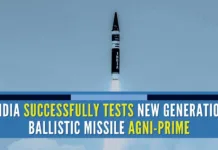
The intent to make infrastructure and facilities available on demand will greatly enhance the ability of MSMEs to participate & contribute to the defence needs.
On Feb 1, 2018, the Finance Minister announced the formation of Defence Corridor in two states in India as part of budget announcements – first one in Tamil Nadu and the second one in Uttar Pradesh.
Ever since Ms. Nirmala Seetharaman took over as the Defence Minister in last September/October, the Ministry of Defence has been fast-tracking many initiatives and continuing the good work started by previous full-time Defence Minister – Mr. Manohar Parikkar.
The Ministry of Defence has empowered its various departments to meet with the industry leaders and get feedback on various policies and procedures that can make Defence Manufacturing a key component of “Make in India” – a major initiative by the Government of India – to be successful.
The government wants to reverse the current import/domestic purchases from 70/30 to at least 50/50 in the next 10 years.
The Indian procurement of Defence products over the next decade or so is expected to exceed over the US $150 Billion and India will soon become the third largest buyer of Defence products in the world. This obviously makes India a target country for leading exporters of Defence products and services from USA, Europe, Russia, Japan, Israel and other countries.
Also, as a large buyer of Defence products, India can do so on its own terms and conditions. This is where the concept of “Offsets” comes in among other aspects of the terms and conditions. Offsets require the Country/Company that wants to sell Defence products to Indian buyer (Ministry of Defence) that a portion of the value of the purchase (typically 30%) be generated in India through Indian manufacturing and services partner companies – this means that over the US $50 Billion worth of opportunity awaits the Indian industry, academia, and other stakeholders.
India currently imports over 70% of its needs from abroad while DPSUs (Defence Public Sector Undertaking) and private companies produce the remaining 30%. DPSUs have largely led this even before Independence. Over the last 10-20 years, Indian private companies who have partnered with DPSUs or with Foreign OEMs (Original Equipment Manufacturer) have developed capability in a limited way.
 The Indian defence ecosystem will take another 10+ years to evolve into the future defence structure illustrated above. Currently most of the MSMEs (Micro, Small and Medium Enterprises)involved in defence production work mostly with the Defence PSUs and are a frustrated lot due to lack of consistent orders, payment delays, unusually long periods for product approvals (as the end user, the tri-forces have to approve the product in combat environment), lack of cooperation within the DPSU ranks and hierarchy to support indigenization efforts and bureaucratic wrangles over Intellectual Property, licensing mechanisms and dual-use policy, to name a few.
The Indian defence ecosystem will take another 10+ years to evolve into the future defence structure illustrated above. Currently most of the MSMEs (Micro, Small and Medium Enterprises)involved in defence production work mostly with the Defence PSUs and are a frustrated lot due to lack of consistent orders, payment delays, unusually long periods for product approvals (as the end user, the tri-forces have to approve the product in combat environment), lack of cooperation within the DPSU ranks and hierarchy to support indigenization efforts and bureaucratic wrangles over Intellectual Property, licensing mechanisms and dual-use policy, to name a few.
Luckily the present government, under the incumbent Defence Minister, is working hard and feverishly to remove many of the hurdles in the way. The Defence Procurement Procedure (DPP) 2016 proposed amendments to offsets managements (currently in draft stage), changes to Make I policy with newly introduced Make II policy (aimed at MSMEs) and Draft Defence Production Policy 2018.
Along with these, the intent to make infrastructure and facilities available on demand for MSMEs will greatly enhance the ability of MSMEs to participate and contribute to the defence needs.
In addition, the MoD is continuously finding ways to support MSMEs. Focus on startups through separate funding, helping cash flow for those doing business with DPSUs through bill discounting facilities at DPSU itself, funding for common infrastructure for testing and validation are a few examples.
In addition, the removal of many items from a controlled list (those currently only made at DPSUs) and also increasingly removing hurdles in exports by easing export procedures, thus promoting the companies to go global, will also help.
The government wants to reverse the current import/domestic purchases from 70/30 to at least 50/50 in the next 10 years. The government has also set export targets (excess of Rs 30,000 crores in 5 years) for defence products out of India to countries in the region and developing nations who see value in Indian developed defence products.
The above clearly shows that the government, and in particular the MoD, understands that in order for defence production to grow in India, the unshackling of limitations, rules, and procedures are required speedily.
However, the industry also needs to take advantage of the new environment for doing business in defence. While many policy changes are proposed, the impact of these will take some time to fruition.
Skill development is another area where there are lots of requirements and this is another opportunity for other entrepreneurs to target this.
For MSMEs already in defence, this is a very good time to move ahead by managing their focus on their areas of strength and leveraging the new environment. They need to align with bigger companies, private and public sector units, to become a valued supplier.
They should also reach out to global defence players showcasing their Indian pursuits and demonstrating their capabilities to be a reliable partner for meeting the Indian market needs and global market needs as well over time.
For those companies desiring to enter into defence, whether big or small, they should understand the dynamics of the defence business: low volume, very high quality, long cycle time, cash flow issues, medium to high profit and also access to technology. This industry rewards those individuals and companies who are ready to invest for the long haul and have a passion for this industry.
With the setting up of the defence corridor in Tamil Nadu, the focus is now on Chennai -> Trichy -> Coimbatore -> Salem -> Hosur. Each of these hubs has unique capabilities serving other industries and these need to be harnessed by the desirous industrialists and the business opportunities taken advantage of, thereby helping Indian defence as well.
In Chennai and Coimbatore, the engineering and automotive industry experience can be further enhanced to meet the needs.
Trichy is full of companies with deep experience in heavy engineering and has great capabilities to support large-scale manufacturing for the Navy or Army needs. Hosur and Salem can also grow their speciality skills to support the defence opportunities.
With over Rs 3000 crores of funds from Central Government, matched with an equal amount from State government, a lot of common infrastructure and facilities can be expected. Skill development is another area where there are lots of requirements and this is another opportunity for other entrepreneurs to target this.
The road to success is being paved by the government, which is committed to supporting MSMEs. Passionate and committed MSMEs getting into defence production are likely to succeed in the coming years. The author is ready and willing to help the interested entrepreneurs.
Note:
1. The views expressed here are those of the author and do not necessarily represent or reflect the views of PGurus.
- Defence Corridors: Opportunity For MSMEs - May 25, 2018






A well thought out article. One of the main hurdle that I am experiencing is DIPP licensing delays, esp for MSMEs. It is about two years since we made one of the applications and still not cleared. Another aspect I feel in the future model shown is there is a strong chance that an an intermediate sub-system supplier emerging between the component suppliers and integrators – mainly due to the multi skill, multi discipline knowledge that is needed even at sub system levels. Yes, it may take 10 or more years to evolve, but there is a strong chance that it will be there and it will be vital to the growth of the Defense Mfg sector. A value distribution of 30-30-40 possibility from component to tier 1 integrator. At that mature level, we could see that we will be making about 80% of our requirements and the indian def industry exporting around 30-40% of its output. In many areas, even for SMEs to visualize and operate on global scale is important to be very successful.